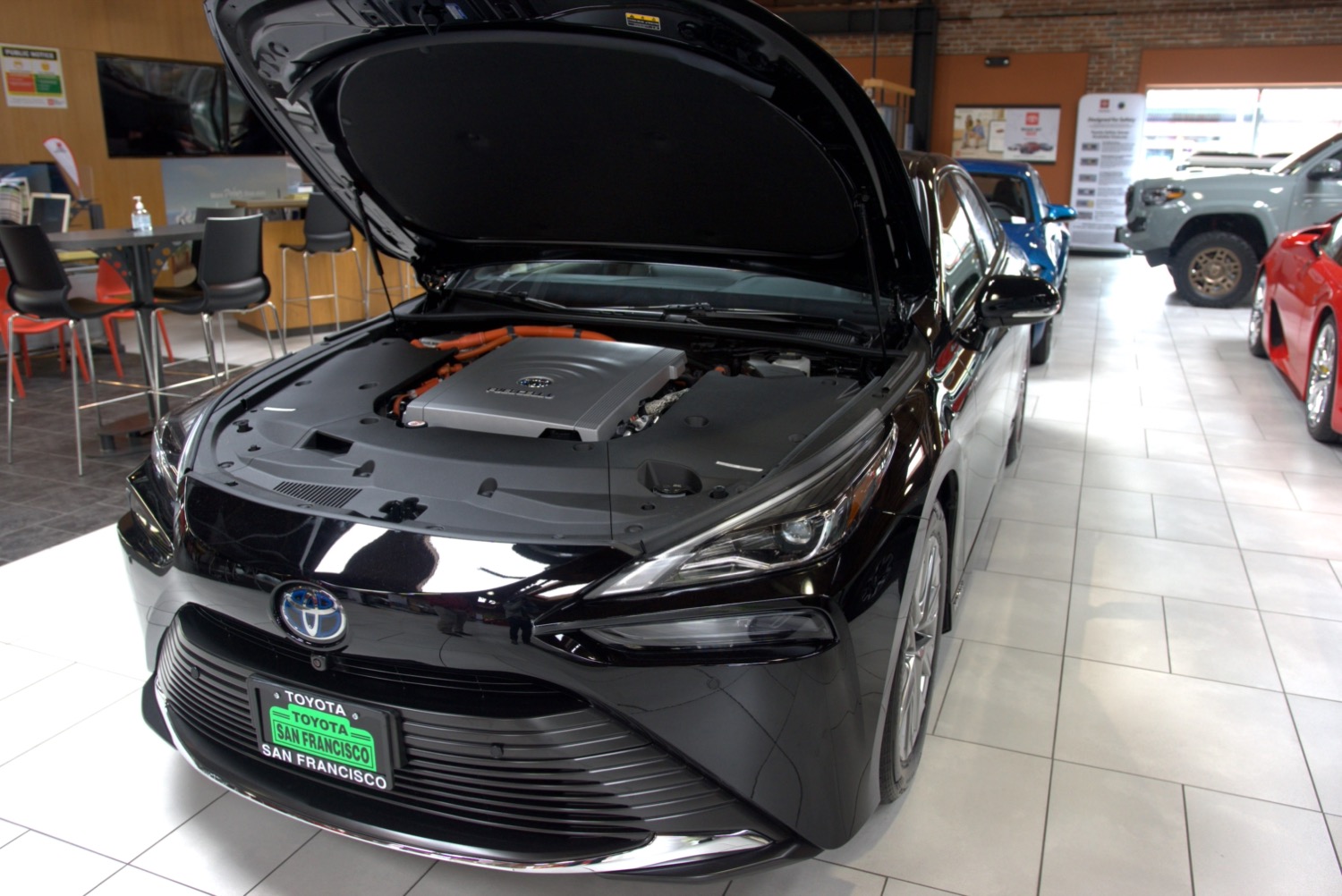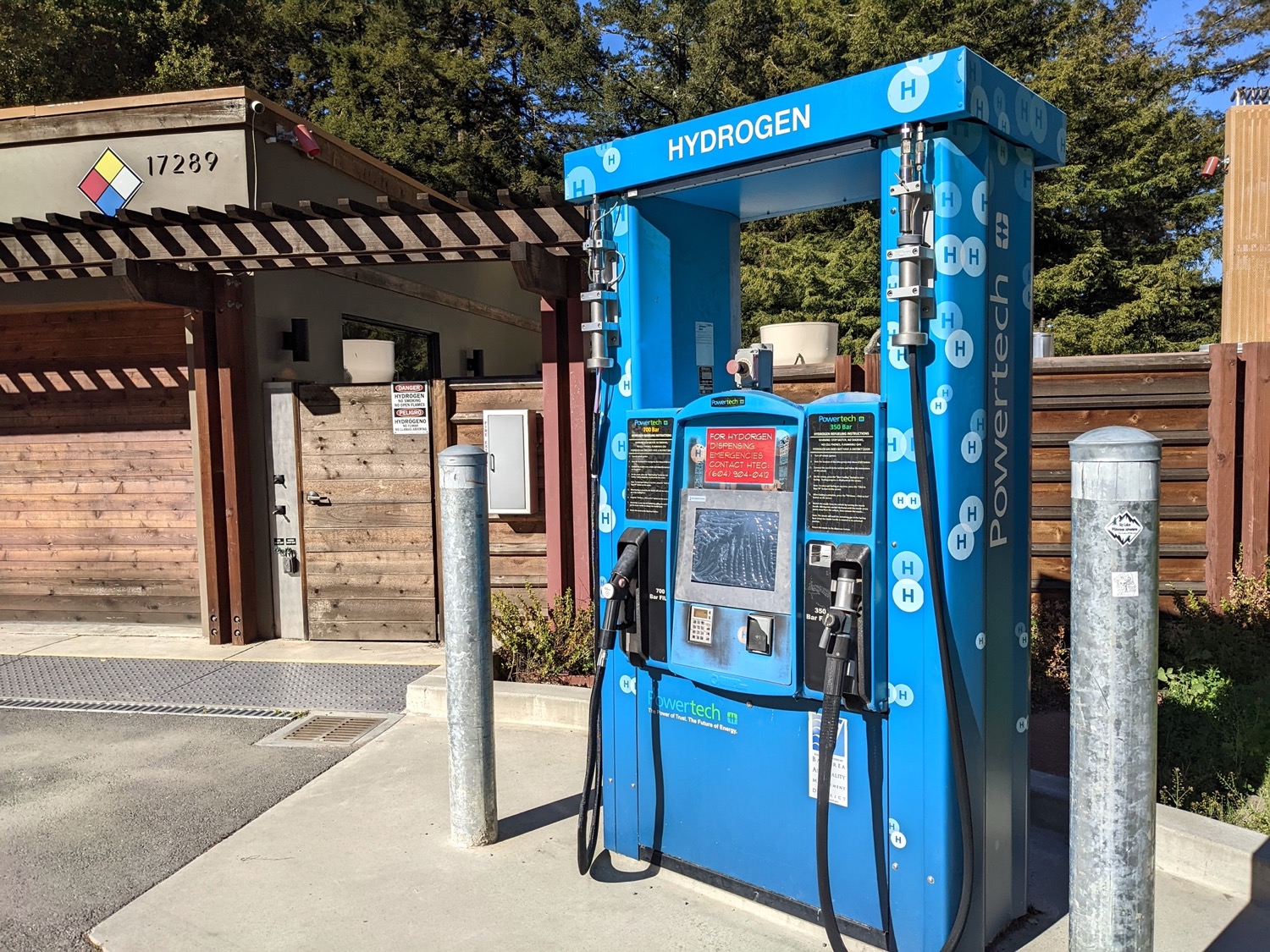Can Hydrogen-Fuel Cells Drive The Car Market?
8:56 minutes

If you’ve been shopping for a new car recently, you may have been struck by the number of electric vehicles available from different manufacturers. According to Kelley Blue book data, Americans bought almost twice as many EVs in the first quarter of 2022 compared to the first quarter of 2021, with battery-powered electric vehicles reaching 5% of the new car market for the first time.
But electric isn’t the only alternative to the traditional gasoline or diesel powered car—there are also hydrogen fuel cell car options, such as the Mirai, a hydrogen fuel cell car from Toyota. In those vehicles, compressed hydrogen is used in conjunction with a catalytic fuel cell membrane to generate the electricity to drive the vehicle. Cars using the technology can have a 300-mile range, with fuel-ups taking as little as five minutes. And while today much of that hydrogen comes from fossil fuels, there is the potential for it to come from electrolysis of water via renewable energy, such as solar or wind.

But there are big technological and infrastructure challenges to solve before fuel cell technology could compete with the battery-powered electric car. Joan Ogden, a professor emeritus of environmental science and policy at UC Davis, joins Umair Irfan to talk about the requirements for building the refueling infrastructure that would make fuel cell vehicles a more attractive option to consumers.

Invest in quality science journalism by making a donation to Science Friday.
Joan Ogden is a professor emeritus of Environmental Science and Policy at UC Davis in Davis, California.
UMAIR IRFAN: This is Science Friday. I’m Umair Irfan. If you’ve been shopping for a new car recently, you may have seen a surprising variety of electric vehicles available for sale. According to Kelley Blue Book data, electric vehicles made up about 5% of total car sales for the first time. And Americans bought twice as many EVs in the first quarter of 2022 than they did in the first quarter of 2021.
However, electric isn’t the only option for going green. There are also hydrogen fuel cell car options. While visiting California recently, I rode an electric motorcycle over to a dealership to test drive the Mirai, a hydrogen-powered car from Toyota. The word “mirai” is Japanese for future.
But what would it take for hydrogen to become part of our clean energy future, particularly when it comes to transportation? There are some big technological and infrastructure challenges that hydrogen has to overcome first. Joining me now is Joan Ogden. She’s a Professor Emeritus of Environmental Science and Policy at the University of California Davis. Welcome to Science Friday.
JOAN OGDEN: Thank you very much. It’s a pleasure to be here.
UMAIR IRFAN: As I mentioned, I drove this Toyota Mirai in San Francisco. And it was pretty slick. It had a very quiet interior, very quick acceleration because it has that electric motor.
But then I went to the nearest Hydration Station in San Francisco and both of the pumps were out. Then I went to another station that was further south in the Bay Area. And it looked like that hydrogen pump hadn’t run for years. So what’s holding back hydrogen infrastructure?
JOAN OGDEN: Well, introducing hydrogen vehicles, the infrastructure has to go along with it, because unlike electricity, where you have it at people’s homes or many spots, or unlike gas stations, which are ubiquitous, with hydrogen, you need to build that system up. California has been implementing a network of stations as cars have been rolled out there. There are, I think, about 8,000 or 9,000 fuel cell vehicles in California now, many of them the Toyota models. So the state of California has put a lot of effort into this design of this new system.
One thing is you want to have the stations where the people are. And so they have developed a plan and have been implementing, I think it’s about 51 stations are active now. They’re expecting about another 120 over the next few years to be built. And if you put them in the right place near where the car owners are, that turns out to be enough of a network to support travel as you would want to travel in a hydrogen car. So the infrastructure has been the rate limiting step though in many ways, because you have to have these two things happen in concert.
UMAIR IRFAN: Well, tell me a little bit about the stations themselves, how different are they from conventional gasoline stations? And what makes them unique?
JOAN OGDEN: OK, so hydrogen stations, hydrogen is dispensed to vehicles as a compressed gas. And gasoline, of course, is a liquid. Liquids pack a lot of energy into a small volume and weight. With a gas, you need a larger system to contain that gas, both on the car and at the station.
So the equipment’s a little different. Have compressors. You have a different kind of hose that goes into the car. The refueling experience, though, in some ways is quite similar in that it doesn’t take very long to fill up your hydrogen car. And that’s very similar to a gasoline car.
You also can have a large range with a hydrogen car. And hydrogen cars are in the 300 mile plus range now. So behaviorally, going to the refueling station and driving off and taking a long trip should be more similar to gasoline with hydrogen than it is with an electric battery car.
UMAIR IRFAN: Of course, it’s not enough to have just the refueling station. You also have to get the hydrogen to the station. So how does that work?
JOAN OGDEN: So in many ways, it’s analogous to electricity. You can make it from a lot of sources that are green, that is, don’t produce greenhouse gases or pollutants in their production or use. And these would be things like solar and wind. So those are the long-term goal, really, to produce hydrogen from renewables.
At present, hydrogen, though, is made mostly from fossil fuels, primarily from natural gas in this country. And most hydrogen is made for industrial uses. It’s used to make chemicals. It’s used in oil refining. It’s used to make chemicals like ammonia and methanol.
If we scale up transportation, those uses will become as large as the industrial uses or larger. And we’ll need to switch from fossil fuels to green hydrogen. There’s an intermediate step, where you can take a fossil fuel, like natural gas, and you have CH4 there. You take the H2 off and the carbon goes off as CO2. You can actually capture that CO2 and store it underground. And there are a number of projects around the world that are doing that.
That’s called blue hydrogen. It’s an intermediate step. You capture the carbon, store it underground, and use the hydrogen from a fossil fuel, like natural gas. But green hydrogen is really the goal. And in California, there are actually policies that require that we move toward an increasing fraction of green hydrogen over time.
UMAIR IRFAN: A decade ago, it was an open question which technology would win out when it comes to passenger cars. And now it seems that battery electric vehicles have taken a commanding lead. Do you think hydrogen can catch up?
JOAN OGDEN: That’s a great question. That’s a really interesting question. Think battery cars have come a long way, as have hydrogen cars, in terms of the technology, in terms of the range that’s achievable, and the types of models that are out there now. Batteries do have the advantage we were talking about earlier with infrastructure, is electricity is more ubiquitous than hydrogen.
But the decision also rests in the hands of consumers. So one question is, will there be consumers who want to have the long-range fast refuel and larger vehicle format that works better perhaps with hydrogen fuel cell than with battery? It may be that when you get to larger cars, which lots of folks in America like, that a fuel cell and hydrogen will be better suited to the kind of duty cycle they want to use that car for. And that also counts as we get into things like larger vehicles like trucks.
UMAIR IRFAN: No, that was my exact next question. Where, what applications does hydrogen have a distinct advantage?
JOAN OGDEN: Well, it really helps to think about the kind of wonky concept of energy density here. Energy density means you can pack a lot of energy into a small volume in weight. And that’s very desirable in a fuel on a vehicle. You don’t want to carry any more weight and volume than you have to. Liquid fuels are great for that.
Batteries and hydrogen take up more weight and more room to have the same amount of energy on board. If you have a vehicle that needs a lot of onboard energy storage, let’s say you a long-haul truck, it could be that loading up the batteries are going to take up both space, which displaces cargo, and add weight. And so above a certain size of vehicle and amount of energy storage needed, it could be that hydrogen, which is intermediate in energy density between gasoline and batteries, somewhere in the middle, would be preferable if you want a zero-emission long-haul truck. That’s one of the so-called hard to decarbonize sectors, is long-haul trucks. And hydrogen may play a role there, where electricity would be less practical.
UMAIR IRFAN: It does seem like there’s a lot of potential for hydrogen. But what needs to fall into place in order to make all these things happen?
JOAN OGDEN: To make all these things happen, we need to scale up various parts, especially the hydrogen production and delivery system. And we need to also bring the renewable part of it and the low carbon part of this to the fore. That switch is going to take time. And scaling up with hydrogen, as the delivery system gets larger, the cost is going to come down.
Fuel cells, the costs, again, are projected to come down. They have come down dramatically. I’ve been in this field for a long time and the costs have come down to a point where they are competitive for certain applications. The cost can come down more.
There also are some of the components that go into fuel cells, some of the materials, things like platinum and catalysts that are needed for some types of fuel cells, finding new ways to do that, finding new membrane materials for proton exchange membrane fuel cells. There are a number of parts of the fuel cell where there could be materials research and so on that could improve this. But a big part of it is manufacturing and scale up in manufacturing as well, even with the technologies we have now.
UMAIR IRFAN: So then given the recent surge of investment we’ve seen in hydrogen and all this interest, how soon do you think it’ll be able to play ball with battery electric vehicles?
JOAN OGDEN: Well, I think hydrogen may take up some different segments of the transport sector than battery electric vehicles. And it may be that they serve different purposes for transportation in a low-carbon future. But I think with continued support and development of refueling systems and stations and renewable production that we could see hydrogen by the 2030s really becoming a major player.
UMAIR IRFAN: We’ll have to wrap it there. Joan Ogden is a Professor Emeritus of Environmental Science and Policy at UC Davis. Thank you again for taking the time to talk with me.
JOAN OGDEN: My pleasure.
Copyright © 2022 Science Friday Initiative. All rights reserved. Science Friday transcripts are produced on a tight deadline by 3Play Media. Fidelity to the original aired/published audio or video file might vary, and text might be updated or amended in the future. For the authoritative record of Science Friday’s programming, please visit the original aired/published recording. For terms of use and more information, visit our policies pages at http://www.sciencefriday.com/about/policies/
As Science Friday’s director and senior producer, Charles Bergquist channels the chaos of a live production studio into something sounding like a radio program. Favorite topics include planetary sciences, chemistry, materials, and shiny things with blinking lights.